Giving a virtual guest lecture
 Saturday, May 23, 2020 at 1:01AM
Saturday, May 23, 2020 at 1:01AM 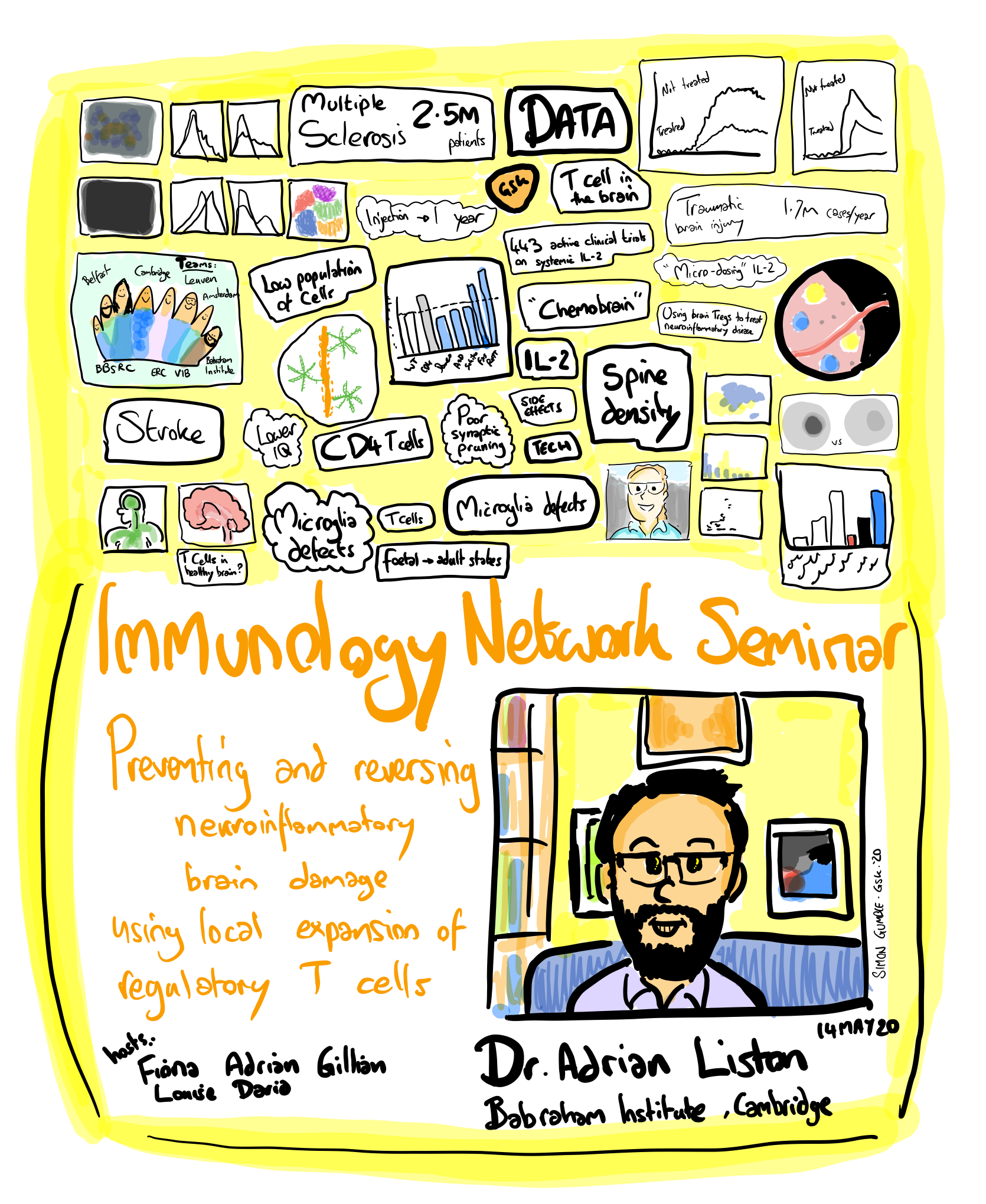
Cartoon courtesy of Simon Gumble, GSK
 science communication
science communication Becoming a Scientist
Virus Fighter
Build a virus or fight a pandemic!
Maya's Marvellous Medicine
Battle Robots of the Blood
Just for Kids! All about Coronavirus
 Saturday, May 23, 2020 at 1:01AM
Saturday, May 23, 2020 at 1:01AM 
Cartoon courtesy of Simon Gumble, GSK
 Monday, May 18, 2020 at 2:24PM
Monday, May 18, 2020 at 2:24PM This recent twitter thread from a first-gen graduate asking about a PhD got me thinking. As a first-gen graduate myself, what advice would I give to someone starting a PhD? The below is tailored towards a biomed PhD in the UK/EU/Australian systems, but some points are more generalisable:
First, getting into a PhD program is tough. You've made it, congratulations! By definition you have the intellectual ability to finish. Never doubt that. That said, you will doubt it. Especially at the 3-6 month period and at ~2 years in. That is normal. Even though the people around you look confident, they all went through a similar period.
Second, it is your PhD, but the lab's project. You should aim to become the intellectual leader of the project after around a year, but always lead with humility. Others around you will always know more than you on specific techniques or domain knowledge. Being the leader doesn't mean be the boss. It means being the person who makes sure that things are on track, who takes responsibility for keeping up with the literature and following up with people who are part of the team.
Ask for advice, and listen to that advice. Take particular note when it comes from experience. Don't be that student who ignores technicians. When a tech is telling you something, listen. If your supervisor tells you something, listen. Feel free to disagree, but first listen. If someone suggests a protocol for an experiment, do not go back to them for help until you have actually followed their protocol word for word. Don't change protocols that work until you've got a lot more experience. Include every control that is suggested, even the ones you don't think are necessary.
Being a PI is a tough job, very time-demanding. So use their time wisely. Prep before a meeting, take notes during, follow-up. If you can answer a question via a quick google search or conversation with another lab member, do that instead of knocking on their door. A PI can be a valuable asset to you if you use their time wisely. If you start wasting their time they will schedule you out,
The lab environment can be a pressure-cooker of stress. Experiments don't work, trouble-shooting is horrible, publication can be nightmarish. At its best, the shared adversity will create unbreakable bonds between lab members. To make this happen, be considerate, be kind, forgive. Be the team member who helps out. Smile when someone frowns - they may have just had the most horrid day. Soon enough you have a day where you snap or frown - treat them the way you would like to be treated on your worst. Especially keep in mind that science is highly international and multi-cultural, and people may not mean things the way you perceive them (and vice versa).
At the start, get into the lab and learn how it works. Where the tip-boxes go, who refills them and makes up new solutions, how plastics get ordered. Ask the lab manager or senior tech what you can do to help out. There are no magic fairies - every task is done by the team. If you leave the centrifuge messy, use the last reagent without ordering more, you will annoy people. If you clog up their personal pipettes and don't tell anyone, you will really annoy people. Be a good lab citizen.
The first six months is basically you learning how to be in the lab, reading the basic literature and just learning how to do the techniques. You won't actually make any advances - this is all on-the-job training.
Don't hide mistakes. You are going to make mistakes. You are going to make mistakes that will cost your monthly rent's worth in grant money. I remember the horror of breaking a haemocytometer during my first week in the lab. $500 at a time where that was an unbelievable amount of money to me. You make make mistakes that cost your annual salary's worth. Own them. Admit to them. Don't make them again. Never blame others for your mistake. Someone breaking the centrifuge is bad, but if I know they will never do it again I move on. If they blamed someone else for leaving it unbalanced (while they didn't check) then I worry that they haven't taken responsibility and are more likely to make the same expensive mistake again.
You are now the senior PhD student that juniors look at. They see you as calm and capable. You have become a data machine. In about six months you pump out 90% of the data of your PhD. At the same time, you probably see yourself as a bit of a fraud: you know you can handle the day-to-day of the lab, but you doubt you can handle the intellectual side still. Your supervisor now becomes your key asset, probably for the first time, as you start to write up.
Don't spend much time on your first draft, it will be rubbish anyway. Everyone's is. Just write it up and get feedback. Just like any technique, writing is a skill that you will learn, you just have to be willing to give it a shot, get feedback, and try again. This means when you your draft back full of revisions, don't just accept the changes. Try to understand them. What change did you PI make, and could you incorporate that strategy yourself next time? In particular, read papers while writing. Compare your paper to published papers, sentence by sentence to see if your work looks like the real thing. What do figure legends have in your field? Does your draft figure legend have all of these attributes? Remember you are the paper lead, but it is a consensus document. Be generous on coauthorship, and remember who helped you out early on. It means a lot to people to be acknowledged, and it doesn't hurt you to have extra authors on your paper.
 Publication. Ah, this is a horrible ordeal. You will get rejected multiple times, it will feel rubbish. Flip that paper to the next journal and don't take it personally. Don't dwell too much on the comments, the next reviewers may be completely different. If your paper is given a "major revision" - congratulations! That is actually really good news. Now you need to do all the experiments that the reviewers asked that are at all possible. Yes, you could argue the point, but save this for the cases where the experiment is impossible. It is much better to deal with a major revision than to start fresh with a new journal. At the end, you may feel more exhaustion and relief that the paper is off your plate, rather than actual satisfaction. This is (unfortunatey) normal. So make sure you celebrate every intermediate stage (submission, going out to review, major revisions coming back, etc).
Publication. Ah, this is a horrible ordeal. You will get rejected multiple times, it will feel rubbish. Flip that paper to the next journal and don't take it personally. Don't dwell too much on the comments, the next reviewers may be completely different. If your paper is given a "major revision" - congratulations! That is actually really good news. Now you need to do all the experiments that the reviewers asked that are at all possible. Yes, you could argue the point, but save this for the cases where the experiment is impossible. It is much better to deal with a major revision than to start fresh with a new journal. At the end, you may feel more exhaustion and relief that the paper is off your plate, rather than actual satisfaction. This is (unfortunatey) normal. So make sure you celebrate every intermediate stage (submission, going out to review, major revisions coming back, etc).
Remember you don't actually need to publish to graduate (in the UK or Australia, in much of the EU you do, but there is a journal home for every paper). You just need to produce a body of work suitable for publication. Like your paper, just push out the first thesis draft quick and dirty. It is a formality, nothing more. Your contribution is in your papers, while your thesis will be read by the jury only, and then gather dust on the shelves somewhere.
Congratulations! You have a PhD. The highest degree possible. You are now an expert in your chosen field (although we all have more to learn!). You have many, many good career options available to you. A PhD in biomedical sciences is a gateway to so many interesting careers. Go down a pathway that looks interesting to you, and if it doesn't work out, pick a new path. The world is your oyster!
 science careers
science careers  Thursday, April 23, 2020 at 7:01PM
Thursday, April 23, 2020 at 7:01PM Severe congenital neutropenia leaves young patients to contract infection after infection, leading to life-threatening situations. A team of Leuven scientists has identified a novel genetic mutation, pointing to a new causative mechanism for this severe immune disorder.
The story starts with patient Jane Doe, now 19 years old, but diagnosed with severe congenital neutropenia when she was just 2 years old. By that time, she had already suffered an ear abscess, recurring ear infections, bronchitis, sinusitis, tonsillitis and several gum infections.
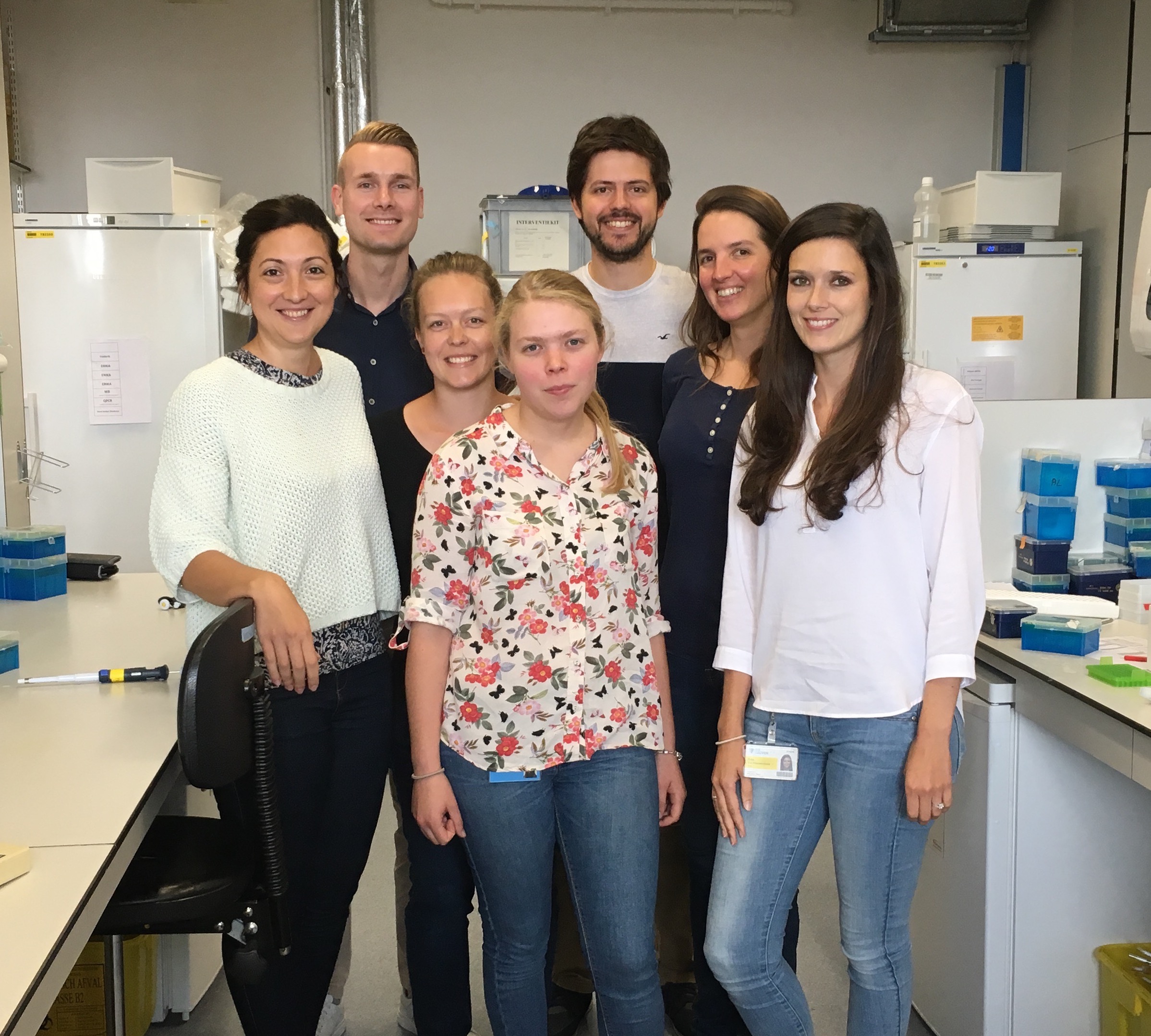 After yet another infection, this time of her intestine, a detailed investigation revealed a striking shortage of neutrophils, white blood cells that are recruited as first-responders to the site of injury or infection within our body. Having an abnormally low concentration of neutrophils in the blood is referred to as neutropenia. When it is severe and present from birth (congenital), that is where the diagnosis of severe congenital neutropenia comes in.
After yet another infection, this time of her intestine, a detailed investigation revealed a striking shortage of neutrophils, white blood cells that are recruited as first-responders to the site of injury or infection within our body. Having an abnormally low concentration of neutrophils in the blood is referred to as neutropenia. When it is severe and present from birth (congenital), that is where the diagnosis of severe congenital neutropenia comes in.
“Severe congenital neutropenia is very scary, because these kids develop serious infections that can be lethal for infants,” explains Erika Van Nieuwenhove. “As if that’s not enough, they are also at increased risk for other conditions such as leukemia.”
Van Nieuwenhove is both an MD and PhD, who combines clinical work in the university hospital with Carine Wouters, with research at VIB and KU Leuven under the guidance of Adrian Liston and Stephanie Humblet-Baron.
Together with John Barber and several other colleagues, she set out to understand why Jane Doe developed SCN in the first place. Van Nieuwenhove: “For up to 50% of severe congenital neutropenia patients, we have no clue what causes the disease. It was the same for our patient, whose parents are both healthy.”
A new mutation in a familiar gene
After Jane Doe tested negative for mutations in all the genes with known ties to neutropenia, the researchers performed whole exome sequencing, probing every gene in the DNA, to trace back the genetic defect underlying the disorder.
“We identified a new mutation in a gene called SEC61A1, which encodes one of three subunits of the Sec61 complex. This molecular complex plays a crucial role in both protein transport and in maintaining the calcium balance of the cell,” explains Humblet-Baron. “Our experiments revealed that the genetic defect led to both a lower expression and a reduced efficacy of the SEC61A1 protein, and that these quantitative and qualitative defects in turn disturb neutrophil differentiation and maturation.”
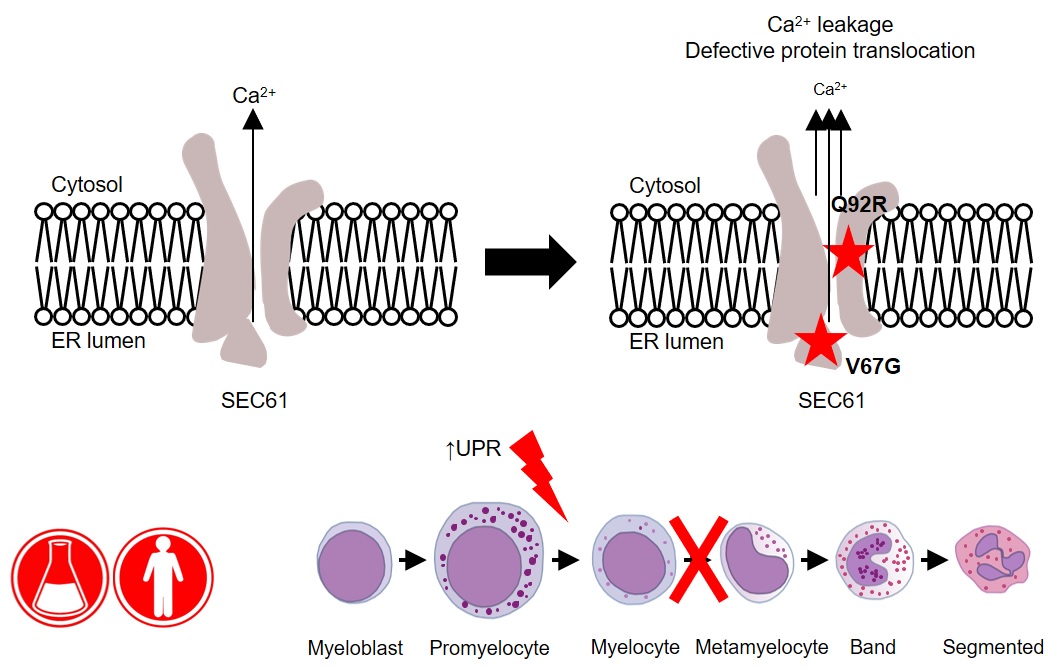
Interestingly, SEC61A1 has recently been picked up in other studies that were not focused on neutropenia. Different mutations in the same gene were reported in two families with a rare kidney disease and in two additional families with an antibody deficiency.
“The fact that there are different mutations in the same gene indicates there may be overlapping mechanisms among the different disorders. With the low number of currently known patients, it is still too early to predict which mutations can lead to which symptoms,” explains Liston.
“What’s clear from our findings is that SEC61A1 mutations can also cause severe congenital neutropenia. Considering this gene’s link with other disorders, the clinical implications of our work reach far beyond the patient with whom it all started here in Leuven.”
—
Read the original paper: Defective SEC61α1 underlies a novel cause of autosomal dominant severe congenital neutropenia. Van Nieuwenhove et al. JACI 2020
 Thursday, April 23, 2020 at 6:49PM
Thursday, April 23, 2020 at 6:49PM Coronavirus science simplified: number 5. This article in Nature Medicine used genetic analysis to test the hypothesis that SARS-CoV-2 was generated in a lab as a bioweapon. Spoiler alert: it wasn't. Clear hallmarks of natural evolution and none of the features of a designed virus. Read the original paper, or see the illustrated abstract by Tenmai.
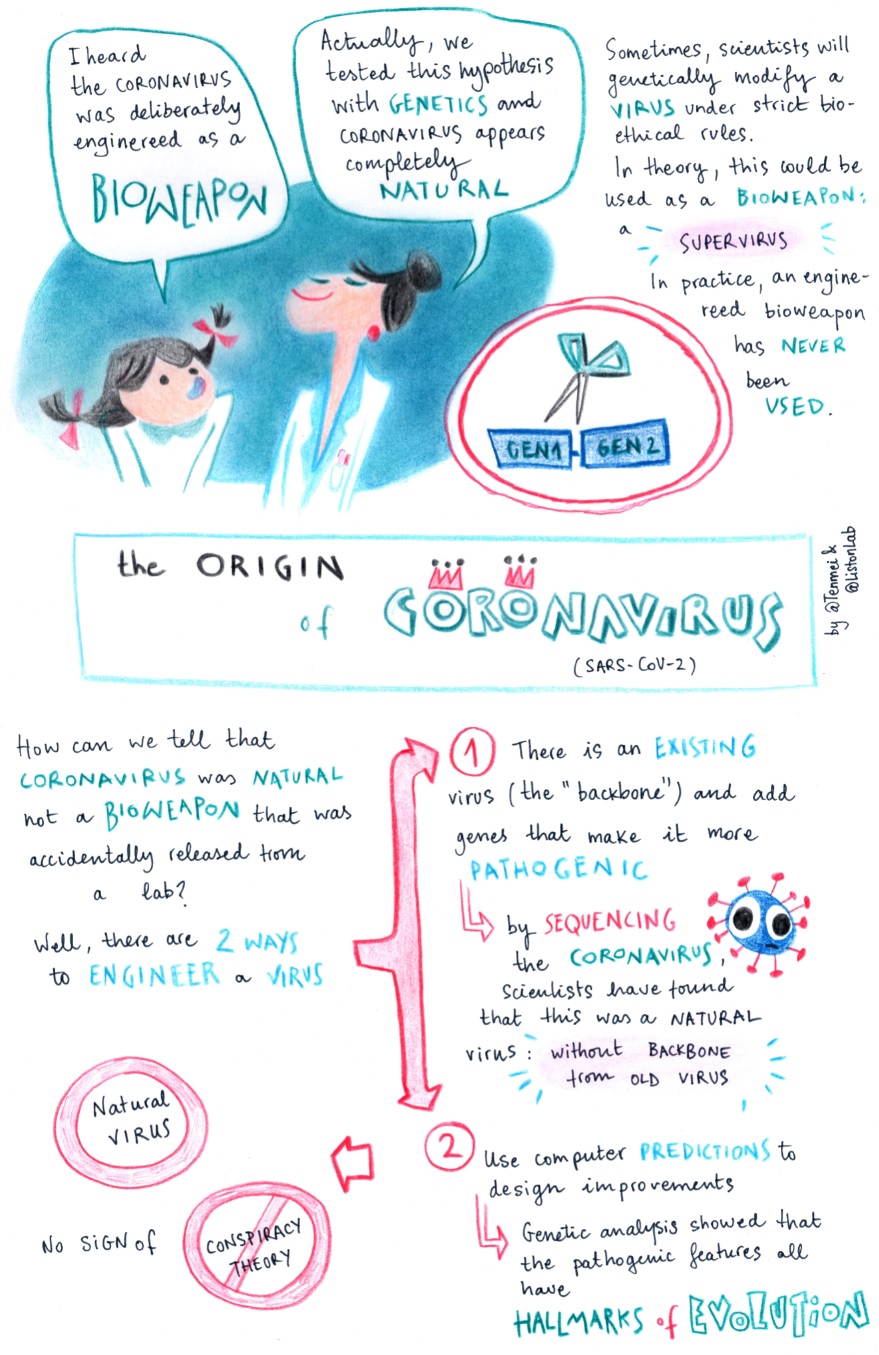
 Thursday, April 16, 2020 at 12:17PM
Thursday, April 16, 2020 at 12:17PM "Coronavirus science simplified" edition 4. This paper looks at the expression of the protein ACE2 in smokers and ex-smokers. Why is this important? Read the pre-print (like a scientific paper, but it hasn't been reviewed yet - consider it a preliminary result), or see the illustrated abstract from TenMei:
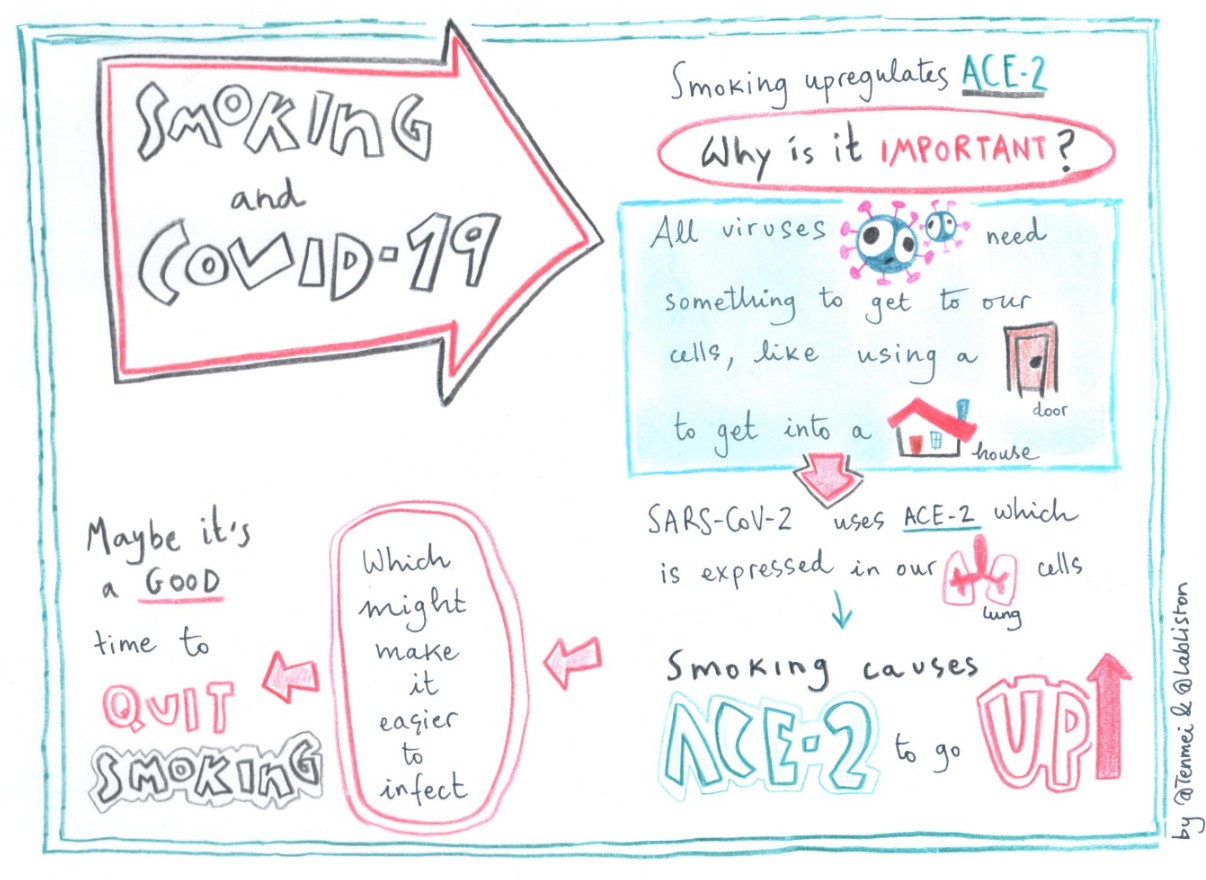
 Wednesday, April 15, 2020 at 11:40AM
Wednesday, April 15, 2020 at 11:40AM The third paper in our series on "Coronavirus science simplified". The talented TenMei is taking cutting-edge papers on Coronavirus and boiling them down to an illustrated abstract. Today's paper is "Respiratory virus shedding in exhaled breath and efficacy of face mask". You can read the original here, with the key message simplified:
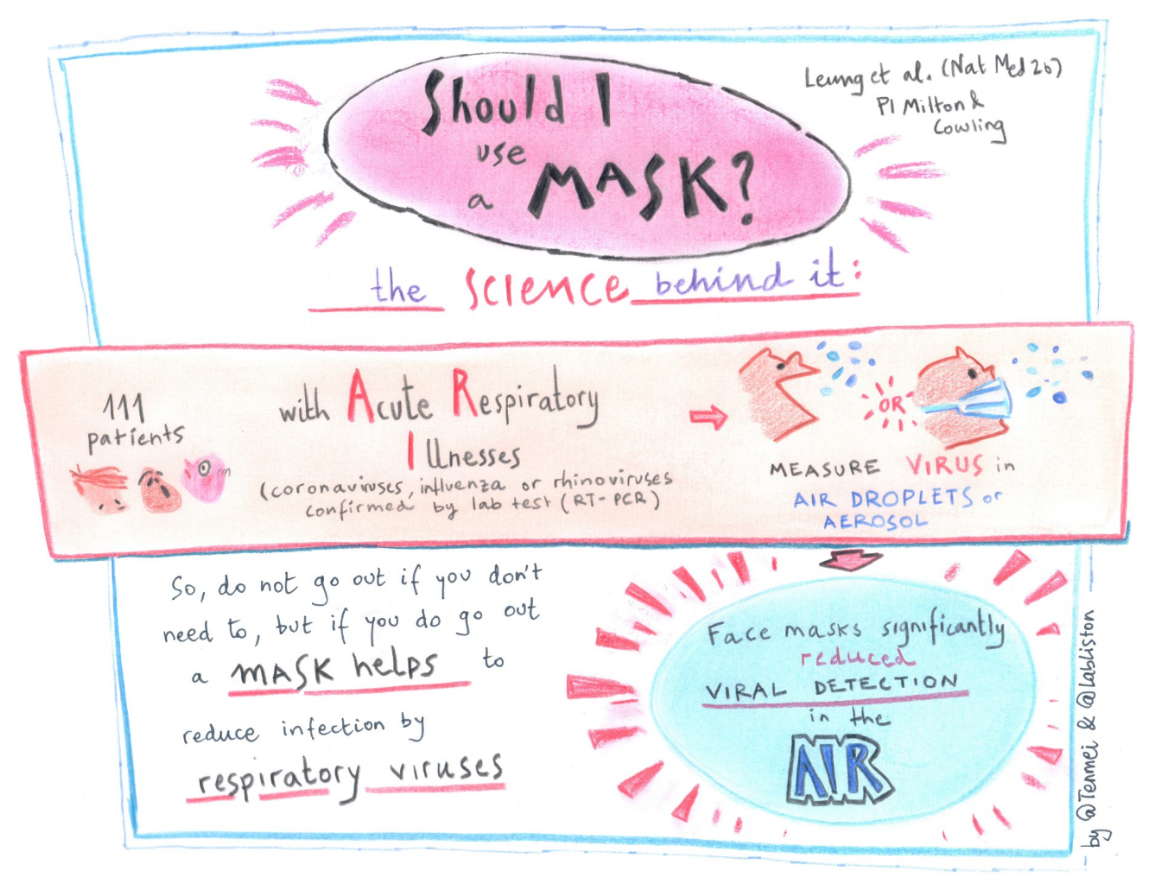
 Friday, April 10, 2020 at 5:57PM
Friday, April 10, 2020 at 5:57PM Due to COVID-19 we have extended the applications for this position for another month.
This is a great opportunity for a scientist to work on an exciting diabetes project in the Leuven lab. Pure cell biology, so we welcome applications from beyond immunology or endocrinology! We have both a research technician and post-doc position available, depending on the experience / background of the applicant. If you are interested, please apply!
 diabetes,
diabetes,  science careers
science careers  Friday, April 10, 2020 at 11:30AM
Friday, April 10, 2020 at 11:30AM 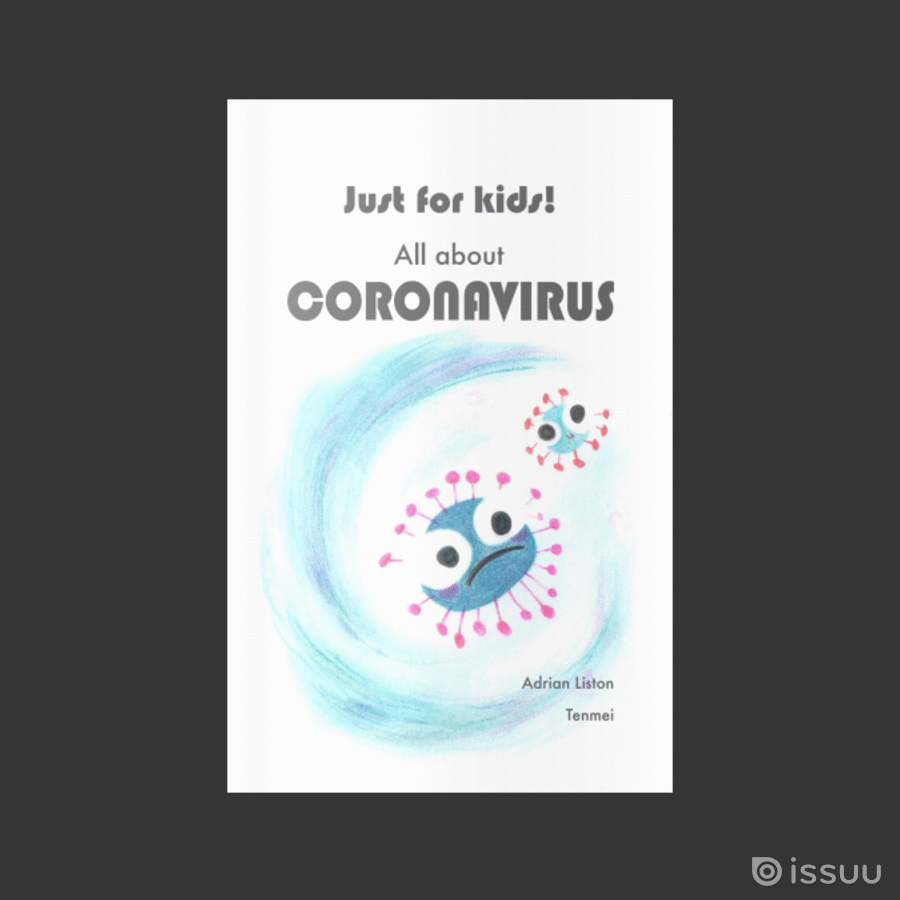 Are you struggling to explain COVID-19 to your kids? Together with Tenmei, we wrote a new kids book to explain what Coronavirus is, how it makes us sick, and why we are in lockdown.
Are you struggling to explain COVID-19 to your kids? Together with Tenmei, we wrote a new kids book to explain what Coronavirus is, how it makes us sick, and why we are in lockdown.
"Just for KIDS! All about Coronavirus"
Suitable for 6-14 year old kids, the book is certified as scientifically accurate by Prof Hedgehog! The story is free on Issuu for everyone to read.
Also available in Spanish.
 Tuesday, April 7, 2020 at 11:31AM
Tuesday, April 7, 2020 at 11:31AM Our final post for "Battle Robots of the Blood"!
Follow the story of Tim, a seven year old who lives a slightly different life to the majority of us. After being introduced to different aspects of Tim’s life, we find out that he has a primary immune deficiency disorder, which means that his immune system can’t protect him against attack from the bacteria and viruses that cause disease. This puts him in in grave danger, especially when exposed to diseases that people could be protected against by vaccination. The story is told in an engaging and light-hearted manner, but still carries the message that vaccination is important for everyone and protects the most vulnerable. The story is beautifully illustrated by Dr Sonia Agüera-Gonzales (Tenmei).
The paperback is appropriate for children 5 to 12 years of age, and is available through Amazon in the US and UK. The English version is available in Kindle stores worldwide, including US, UK and Australia. The associated activity book is free to download here.
The Coronavirus pandemic teaches us that viruses don’t respect borders or linguistic barriers. For vaccination to be truly effective at protecting vulnerable people like Tim, we need to have almost everyone else in the community vaccinated. As scientists we have been historically poor at reaching out to the immigrant component of our communities, and this is reflected by lower vaccination rates. We have therefore embraced the linguistic skills of our international laboratory to translate the book into ten additional languages.
To download the eBook in other languages:
Try French, translated by Prof Stephanie Humblet-Baron, lead of the human immunology team in Leuven.
In Dutch and German, written by PhD students Mathijs Willemsen and Julika Neumann, working in the human immunology team.
In Portuguese, translated by Dr Lidia Yshii, lead of the neuroimmunology team in Leuven. In Spanish, translated by Dr Carlos Roca, head of data science in the Babraham team
In Czech, written by Dr Alena Moudra, in Urdu, written by Dr Samar Tareen, and in Hindi, written by Dr Kailash Singh, all post-docs in the Babraham team. In Polish, written by Urszula Karpinska, from the animal research centre in Babraham, and in Chinese (simplified) and Chinese (traditional).
 Monday, April 6, 2020 at 9:05PM
Monday, April 6, 2020 at 9:05PM  रोहन एक 7 साल का लड़का है। रोहन की प्रतिरक्षा प्रणाली में आनुवांशिक दोष के कारण उसमें प्राथमिक क्षमता की कमी है । यह कहानी रोहन के जीवन और उसके प्रतिरक्षा प्रणाली में कमी का वर्णन है।
रोहन एक 7 साल का लड़का है। रोहन की प्रतिरक्षा प्रणाली में आनुवांशिक दोष के कारण उसमें प्राथमिक क्षमता की कमी है । यह कहानी रोहन के जीवन और उसके प्रतिरक्षा प्रणाली में कमी का वर्णन है।
हर महीने अस्पताल में इलाज के लिए जाना, रोहन के जीवन का एक सामान्य हिस्सा है। उसे इस बात की कोई चिंता नहीं है, लेकिन उसके माता-पिता रोहन के बीमार होने पर बहुत घबरा जाते हैं और परेशान भी बहुत होते हैं। परंतु रोहन के लिए इससे भी बड़ी बात यह है कि जब वो उन बच्चों के साथ नहीं खेल सकता है और दोस्ती नहीं कर सकता है जिन्होंने, टीकाकरण नहीं करवा रखा है।
"बिक्री से प्राप्त आय इम्यूनोलॉजी और टीकाकरण अनुसंधान के उपयोग में ली जाएगी "